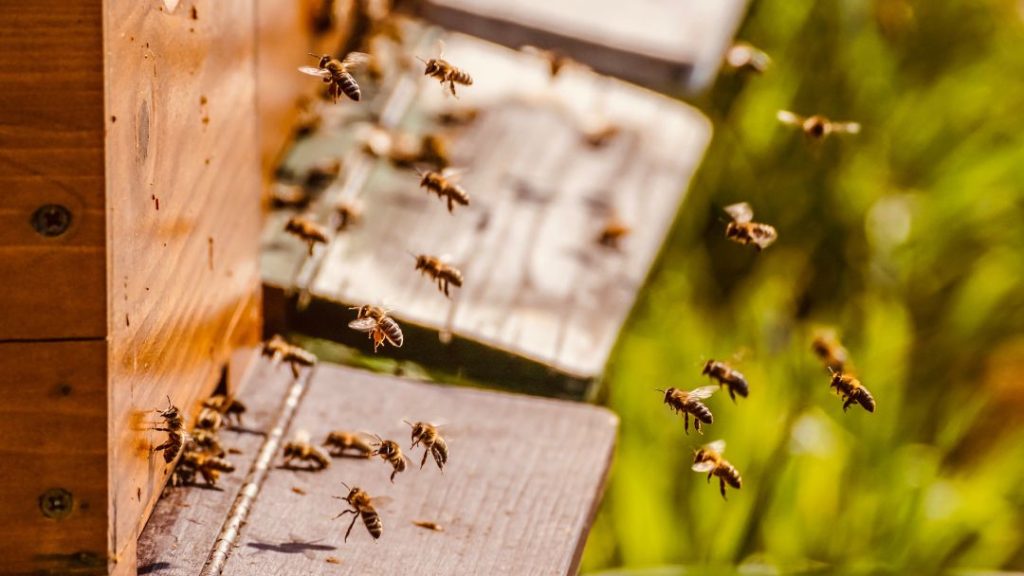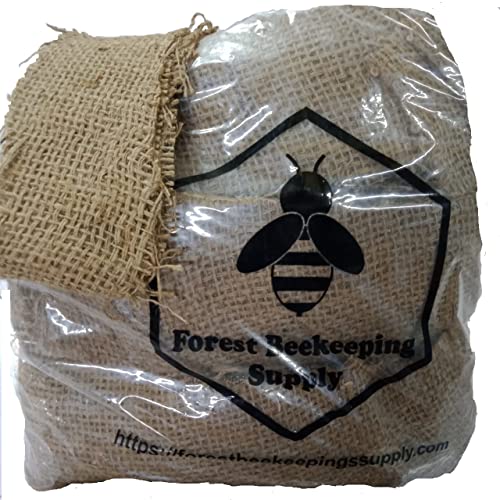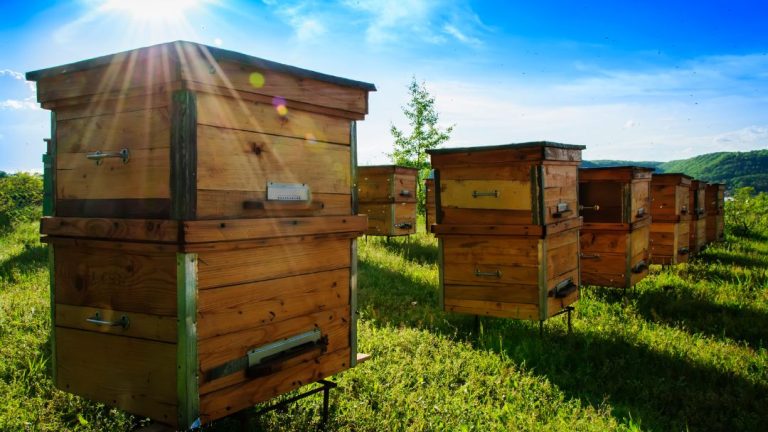The Surprising Benefits of Beehive Ventilation: Unleash the Full Potential!
Beehive ventilation is crucial for maintaining the health and productivity of bees by ensuring proper airflow, temperature regulation, and prevention of moisture build-up, which can lead to the growth of bacteria and fungi. A well-ventilated beehive is essential for the overall well-being of the colony.
Adequate airflow within the hive helps to dissipate excess heat during summer months, preventing overheating and stress on the bees.
It also allows for the removal of stale air and the exchange of oxygen, which is essential for respiration. Proper ventilation plays a vital role in regulating humidity levels within the beehive.
Bees rely on a consistent humidity range for optimal wax production and brood development. Inadequate ventilation can cause condensation to accumulate, potentially leading to moisture-related issues like mold growth and increased vulnerability to diseases.
Beyond temperature and moisture control, ventilation helps to reduce excessive buildup of carbon dioxide and odors, contributing to a cleaner and healthier beehive environment.
Additionally, proper ventilation can help deter pests and mitigate the spread of certain bee diseases. Beehive ventilation is of paramount importance as it facilitates temperature regulation, prevents moisture-related problems, promotes air circulation, and contributes to overall colony health and productivity.
Why Beehive Ventilation Matters
When it comes to beekeeping, proper beehive ventilation is a matter of utmost importance. Adequate ventilation in beehives ensures a conducive environment for the bees to thrive and stay healthy.

Increased Air Circulation And Ventilation For Bees
The first reason why beehive ventilation matters is the increased air circulation and ventilation it provides to the bees.
Just like humans, bees require fresh air to thrive. Good ventilation helps in maintaining the exchange of gases inside the hive, which is crucial for their respiration process.
When hives are poorly ventilated, the air becomes stagnant and stale, leading to a decrease in the overall air quality. This can have detrimental effects on the health of the bees, making them more susceptible to diseases and pests.
Adequate airflow, on the other hand, promotes proper oxygen supply and removal of carbon dioxide from the hive.
By ensuring increased air circulation and ventilation, beekeepers can create a healthier environment for their bees. This allows the bees to effectively regulate their body temperature, enhance their immune system, and overall contribute to their well-being.
Impact On Hive Temperature And Humidity
The second reason why beehive ventilation matters relates to its impact on the hive’s temperature and humidity levels. Maintaining the ideal temperature is crucial for the colony’s survival, especially during extreme weather conditions.
Proper ventilation helps dissipate excess heat during hot summers and prevents extreme cold during winters.
Poorly ventilated hives are prone to overheating, which can lead to detrimental consequences such as weakened bees, decreased honey production, and even colony collapse.
On the other hand, sufficient ventilation allows for the regulation of hive temperature, preventing excessive heat buildup. It also aids in maintaining optimal humidity levels, as excessive moisture can lead to mold growth and diseases.
Reduction Of Condensation And Moisture Build-up
In addition to temperature and humidity regulation, beehive ventilation also plays a crucial role in reducing condensation and moisture build-up.
Bees produce moisture through their respiration and honey-ripening process. If the hive lacks proper ventilation, this moisture can accumulate, leading to a humid and damp environment.
Excessive moisture in the hive can create ideal conditions for the growth of bacteria, fungi, and mites, which can jeopardize the bees’ health. Moreover, the presence of moisture can cause the honey to ferment, making it unsuitable for consumption.
By implementing effective ventilation techniques, beekeepers can ensure the removal of excess moisture, reducing the risk of condensation and water damage.
Adequate airflow allows for the dissipation of excess moisture, maintaining a dry and healthy environment inside the hive.
Surprising Benefits Of Beehive Ventilation
Proper ventilation in beehives is essential for the well-being and productivity of honey bees. While the importance of ventilation may not seem obvious at first, some surprising advantages come with it.
Enhanced Honey Production And Quality
Ventilation plays a crucial role in enhancing honey production and ensuring high-quality honey.
When beehives are properly ventilated, the temperature and humidity levels inside can be regulated, creating an optimal environment for bees to work efficiently. The controlled airflow helps to remove excess moisture from the hive, reducing the risk of honey fermentation and spoilage.
As a result, beekeepers can expect a higher yield of honey that not only tastes better but also has a longer shelf life.
Improved Bee Health And Disease Prevention
Good ventilation is vital for maintaining the health of honey bees and preventing the spread of diseases within the colony. Proper airflow helps to remove stale air, moisture, and harmful gases that can accumulate in the hive.
This ventilation process helps to minimize the growth of mold and fungi, which can be detrimental to bee health.
Additionally, a well-ventilated hive reduces the likelihood of pests and parasites finding suitable habitats, as these unwanted guests prefer damp and stagnant environments.
By optimizing ventilation, beekeepers can proactively protect their colonies from various diseases, allowing bees to thrive and contribute to a healthier ecosystem.
Increased Colony Strength And Productivity
Beehive ventilation is directly linked to the strength and productivity of the entire colony. Adequate airflow assists with regulating the hive temperature, preventing overheating during hot weather, and providing insulation during colder seasons.
By maintaining an optimal temperature, bees use less energy to thermoregulate, which enables them to allocate more resources to foraging and honey production.
A well-ventilated hive also allows for efficient dispersion of pheromones, essential chemical signals that help bees communicate and work together as a cohesive unit. These factors combined contribute to overall colony strength and the ability to meet honey production targets.
When it comes to beekeeping, it is crucial not to overlook the importance of beehive ventilation.
By enhancing honey production and quality, improving bee health and disease prevention, and increasing colony strength and productivity, proper ventilation becomes a valuable ally in the success of your beekeeping endeavors.
How To Achieve Optimal Beehive Ventilation
The importance of beehive ventilation cannot be overstated. Achieving optimal ventilation in a beehive is crucial for the health and productivity of the bees.
Poor ventilation can lead to an array of problems such as increased humidity, mold growth, and the spread of diseases.
The Role Of Hive Design And Construction
The design and construction of the beehive play a significant role in ensuring proper ventilation. The hive should have adequate space for the bees to move around and for air circulation to occur.
Bees are highly efficient at regulating temperature and humidity, but the hive should support their natural behaviors. A well-designed hive with appropriate ventilation features helps maintain optimal conditions.
Practical Strategies For Ventilation Enhancement
There are several practical strategies you can employ to enhance ventilation in your beehive. First, you can add ventilation holes or gaps in the hive boxes.
These openings allow for the exchange of air and prevent the buildup of moisture. Additionally, providing a top entrance can facilitate airflow and improve ventilation. Remember to cover these openings with screens to prevent unwanted visitors from entering the hive.
Another effective strategy is using quilt boxes or ventilation boards. These are placed on top of the hive to absorb excess moisture and provide additional space for air circulation.
The quilt box can be filled with absorbent materials such as sawdust or wood shavings to further improve ventilation and moisture control.
Proper Placement Of Ventilation Openings
The placement of ventilation openings is crucial to ensure effective airflow in the beehive. It is recommended to have a ventilation hole at the top of the hive to allow warm air to escape.
This hole should be positioned away from prevailing winds to prevent drafts. Placing additional ventilation openings at the bottom of the hive can promote the circulation of fresh air and aid in the removal of excess moisture.
Utilizing Screened Bottom Boards
Screened bottom boards are a useful tool for enhancing beehive ventilation. These boards have a mesh or screen bottom instead of a solid bottom board.
The mesh allows for increased airflow, helping to regulate temperature and humidity levels. Furthermore, screened bottom boards can aid in controlling Varroa mite infestations as mites will fall through the mesh and out of the hive.
Beehive Insulation Techniques
Insulation can play a vital role in maintaining favorable conditions inside the beehive. Proper insulation helps regulate temperature and protect the bees from the extremes of weather.
Some popular insulation techniques include using foam insulation boards or insulating wraps around the hive. Insulation should be applied to the sides and top of the hive, leaving the bottom open for ventilation.
Tools And Equipment For Beehive Ventilation
Ventilation is a vital aspect of beekeeping that ensures the health and productivity of a hive. Appropriate air circulation within the beehive regulates temperature, removes excess moisture, and allows for the efficient release of hive odors, resulting in a conducive environment for honeybees.
To achieve effective ventilation, beekeepers rely on an array of tools and equipment designed specifically for this purpose.
Ventilation Boards And Shims
Ventilation boards and shims play a crucial role in enhancing beehive airflow. These tools allow beekeepers to adjust the level of ventilation within the hive, catering to the changing needs of the colony.
Ventilation boards generally consist of a wooden board with strategically placed ventilation holes or screens. Beekeepers can easily insert these boards above or below the hive’s brood boxes to control the flow of air.
Shims, on the other hand, are small wooden spacers that beekeepers insert between the hive components. These spacers help create gaps, allowing air to circulate between the boxes.
By using ventilation boards and shims, beekeepers can ensure that their hives maintain the ideal ventilation levels for their buzzing colonies.
Entrance Reducers And Slatted Racks
Entrance reducers and slatted racks are additional tools utilized by beekeepers to enhance beehive ventilation and reduce congestion at the hive entrance. Entrance reducers are small devices positioned at the hive entrance to regulate the size of the opening.
By adjusting the entrance size, beekeepers can manage the airflow into the hive, preventing unwanted entry of pests and predators while facilitating proper ventilation. Slatted racks, on the other hand, are frames with evenly spaced slats that beekeepers place just below the brood boxes.
These racks elevate the bottom box slightly, creating space for increased airflow within the hive. By employing entrance reducers and slatted racks, beekeepers can promote an optimal ventilation system that safeguards their colonies from various disturbances.
Beehive Gable Ventilation Systems
For larger apiaries or specialized setups, beehive gable ventilation systems offer a comprehensive ventilation solution. These systems typically consist of hives equipped with gable roofs, allowing for improved airflow.
The gable vents are strategically positioned on the sides of the hive, allowing hot air to escape and fresh air to enter. This design optimizes the ventilation within the hive, ensuring a comfortable and healthy environment for the honeybees.
Beehive gable ventilation systems provide an effective ventilation solution for beekeepers with larger-scale operations, prioritizing the well-being of their buzzing colonies.
Conclusion
Proper beehive ventilation is essential for maintaining a healthy and productive bee colony. Good airflow not only keeps the hive cool and prevents moisture buildup, but it also helps regulate the bees’ temperature and expel excess carbon dioxide.
By ensuring optimal ventilation, beekeepers can create a comfortable environment that supports the bees’ overall well-being and productivity.
So, don’t overlook the importance of beehive ventilation – it plays a crucial role in the success of your beekeeping endeavors. Embrace the benefits it offers and watch your bee colony thrive!



